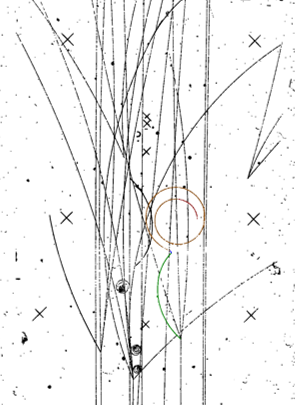Bubble Chamber Pictures for the Classroom
Bubble Chamber
Dive into the fascinating world of bubble chambers and analyse tracks of high-energy particles with your students.
We have developed several activities for advanced high-school students, in which they study bubble chamber photographs and try to work out for themselves what they show. You can find a student worksheet describing these activities (including solutions and additional information for teachers) here: docx, pdf (version 12-03-2018)
Suggestions for educators
- Worksheet activity 1: How does a bubble chamber work? Students read a short text and learn about the different components of a bubble chamber.
- Worksheet activity 2: Electrically charged particles in magnetic fields. Students apply the right-hand-rule to identify tracks of positively and negatively charged particles due to their track's curvature in magnetic fields.
- Worksheet activity 3: Particle identification and properties. Students learn to distinguish tracks of different particles (electrons, "Compton electrons", positrons, and protons) and calculate the momentum of a given particle track.
- Worksheet activity 4: Particle transformations. Students analyse the transformation of a pion.
- Watch a demonstration of a superheated liquid produced by microwaving pure water, which is too dangerous for the classroom.
- Watch a lecture by Don Glaser who won the 1960 Nobel Prize for Physics for his invention of the bubble chamber at Berkeley Lab. He discusses how, inspired by bubbles in a glass of beer, he invented the bubble chamber and detected cosmic-ray muons.
- Find out about recent dark matter detection experiments using bubble chambers from the PICO experiment website and the Fermilab website.
- Bubble chamber art: Bubble chamber patterns also look great as seasonal decorations (e.g., made using the technique of paper quilling) or on dresses. What other creative ideas can your students come up with?
- Online bubble chamber exercises: Find more advanced online exercises on Peter Watkins’s website.
Information text - about bubble chambers
Excerpt from Woithe, Schmidt & Naumann (2019)
From the 1920s to the 1950s, the primary technique used by particle physicists to observe and identify elementary particles was the cloud chamber. By revealing the tracks of electrically charged subatomic particles through a supercooled gas, with cameras used to capture the events, researchers could work out the particles’ mass, electric charge, and other characteristics, along with how they interacted. However, in 1952 the bubble chamber was invented, and this soon replaced the cloud chamber as the dominant particle detection technology. Bubble chambers could be made physically larger, and they were filled with a much denser material (liquid rather than gas), which made them better for studying high-energy particles.
Today, both cloud chambers and bubble chambers have largely been replaced by other types of detectors that produce digital signals and work at a much faster rate. So while photos from bubble chambers are no longer the technology of choice for professional physicists, they can still enrich the discussion of particle physics in the classroom.
How does a bubble chamber work?
The key component of a bubble chamber is a superheated liquid. When electrically charged particles pass through a bubble chamber, they ionise the molecules in the chamber medium. The ions trigger a phase transition and the superheated liquid vaporises, creating visible tracks as bubbles form along the particle’s path. Once the newly formed bubbles have grown large enough, cameras mounted around the chamber capture the event.
Importantly, a uniform magnetic field runs through the chamber, which produces a force on moving electrically charged particles, making them move in curved paths – and creating ‘signature’ shapes for different particles. Measuring the radius of curvature allows a particle’s momentum to be calculated, providing further clues to its characteristics.
Additional material
Read more about an easier version of this classroom activity in 'Science in School': Woithe, J., Schmidt, R., Naumann, F. (2019). Track inspection: how to spot subatomic particles, Science in School, 46
Where can I find bubble chamber photographs?
The images used the activity we propose were produced by the 2 m-long bubble chamber at CERN in 1972. This chamber was filled with 1150 litres of liquid hydrogen cooled to 26 K (–247°C). The bubble chamber was exposed to a beam of protons from CERN’s proton synchrotron PS with a momentum of 24 GeV/c.
Scans of the original photographs, as well as images with coloured tracks, can be found online: https://cds.cern.ch/record/2307419


Find a bubble chamber activity on Twitter or Facebook
#Bubblechambers are able to produce fascinating visualisations of particle tracks, but are no longer used @CERN. Therefore, why not get creative & share your homemade #bubblechamber #kitchenart pic.twitter.com/fS1wX9l9FY
— CERN (@CERN) April 1, 2020